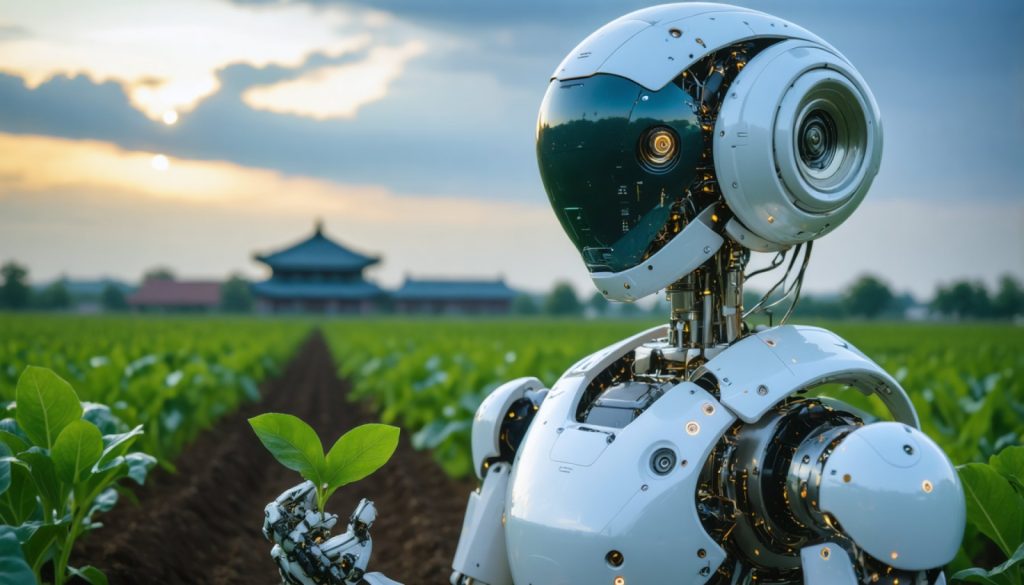
- China’s rural regions are quietly becoming centers of agricultural innovation through the use of artificial intelligence.
- Farmers in provinces like Jilin, Yunnan, and Hubei now utilize AI to address challenges such as climate change and food security.
- AI systems help predict weather patterns, monitor plant diseases, and assess soil conditions, providing practical support for farmers.
- The integration of AI into agriculture represents a shift from global tech trends to localized, tangible solutions.
- China’s approach emphasizes using technology to directly enhance daily life, aiding sustainable development and food security.
- This rural AI transformation highlights the value of grounded, strategic innovation over the pursuit of complex technological advancements.
In the hushed fields of China’s countryside, a revolutionary transformation is stirring beneath the surface. Beyond the skyscrapers and tech hubs of its gargantuan cities, China is becoming a surprising epicenter of agricultural innovation. As the world keeps its gaze fixed on flashy metrics in tech capitals, a new chapter is unfolding in quiet rural corners, where rice paddies become grounds for AI experimentation.
In provinces like Jilin, Yunnan, and Hubei, thrummed by the steady rhythm of agricultural life, farmers are wielding artificial intelligence to combat age-old challenges with new-age solutions. Here, AI isn’t a futuristic marvel but a hands-on tool guiding farmers through the murky uncertainties of climate change and food security.
Imagine a farmer standing knee-deep in the lush green of a rice field, eyes scanning data on a tablet, where once intuition alone dictated the sowing and reaping. These farmers are not writing apps or creating code; instead, they partner with AI systems that predict rainfall, anticipate disease outbreaks, and even gauge soil health.
The goal? To shield their crops from the unpredictable whims of nature. This is AI not wrapped in complex algorithms competing for the next global trend but as a practical ally ensuring yields amid the challenges posed by urbanization and ecological strain.
Vivian Toh, steering the editorial helm at TechTechChina, describes a mosaic of stories weaving through the countryside. These stories depart from the traditional AI narratives dominated by tech giants and financial markets. Here, the emphasis shifts from the global to the local, from the theoretical to the tangible.
The ingenuity lies in China’s approach: Instead of racing towards the biggest GPU or the most intricate model, there’s a profound understanding of AI’s potential to directly improve daily lives. In reshaping agriculture, these smart interventions make significant strides toward global goals of sustainability and food security.
As the rest of the world grapples with sleek tech wars and fiscal maneuverings, the quiet yet powerful symphony of China’s rural AI endeavors sends a compelling message. It suggests a future where technology intertwines intimately with the earth, offering solutions as grounded as the soil under a farmer’s boots.
This rural transformation underscores a key takeaway: In the pursuit of technological advancement, sometimes the most impactful progress comes not from towering leaps but from rooted, grounded steps. China’s farmers are not just cultivating rice; they’re growing an innovative vision of AI that respects and rejuvenates the planet, nurturing a future where technology and ecology coexist in harmony.
How AI is Revolutionizing Agriculture in China’s Countryside
Exploring AI’s Role in China’s Agricultural Renaissance
In recent years, China’s rural landscapes have emerged as unsung canvases for transformative agricultural innovation through the application of artificial intelligence. This shift, quietly unfolding beneath the digital age’s flamboyant tech revolutions, showcases an intriguing integration of AI technology in traditional farming practices, offering sustainable solutions to age-old challenges — particularly in provinces like Jilin, Yunnan, and Hubei.
How AI is Enhancing Agricultural Productivity
1. Crop Monitoring and Soil Analysis: AI systems are aiding farmers by offering real-time data analytics for better crop monitoring. This technology helps farmers detect soil health issues and nutrient deficiencies effectively, ensuring timely interventions that increase yield and quality.
2. Weather Prediction: Farmers traditionally relied on intuition to predict weather changes. AI now equips them with precise forecasting tools analyzing historical data and current climatic patterns to anticipate rainfall and mitigate potential drought or flood impacts.
3. Pest and Disease Management: Machine learning algorithms are employed to detect early signs of pest infestation and disease outbreaks, allowing farmers to manage these threats proactively rather than reactively.
Real-World Use Cases in AI Agriculture
– Predictive Analytics for Crop Yield: Predictive models based on AI are used to forecast crop yields more accurately, helping farmers plan their resources and manage supply chains more effectively.
– AI-guided Drones: These are deployed for planting seeds, spraying pesticides, and monitoring crop health from aerial perspectives, thus enhancing efficiency and reducing manual labor.
Market Forecasts & Industry Trends
By 2025, the global AI in agriculture market is projected to reach billions, with a significant portion stemming from emerging economies like China. The trends indicate an increasing adoption of smart farming practices worldwide influenced by successful ongoing experiments and implementations in Chinese agriculture.
Reviews & Comparisons
China’s AI-driven agriculture model is often compared with approaches taken in the US and Europe. While Western methods focus on high-tech hardware and infrastructure, China emphasizes low-cost, accessible solutions to empower small-scale farmers.
Controversies & Limitations
– Privacy Concerns: With increased data collection come concerns about privacy and data security in rural sectors.
– Skill Gaps: Many older farmers may face challenges adapting to new technologies, presenting a need for comprehensive training programs.
Pros & Cons Overview
Pros:
– Improved yield and crop quality through precise farming techniques.
– Enhanced environmental sustainability by reducing resource waste.
– Strengthened food security and rural economies.
Cons:
– Initial cost barriers may deter smallholder farmers.
– Risk of technological dependency and reduced traditional farming knowledge.
Actionable Recommendations
– Training Programs: Implement workshops to upskill farmers in utilizing AI technologies effectively.
– Investment in Low-cost Solutions: Encourage development and distribution of affordable AI tools to ensure inclusive adoption.
– Data Privacy Measures: Establish frameworks to protect rural farmers’ data while maximizing AI benefits.
Conclusion
China’s strategic integration of AI into its agricultural sector not only celebrates a harmony of tradition with technology but also sets a precedent for sustainable and efficient farming practices globally. As these innovations continue to blossom, they provide a model of how cutting-edge technology can be wielded as an ally to cultivating ecological and economic resilience.
For more on technology trends in China, visit TechTechChina.



